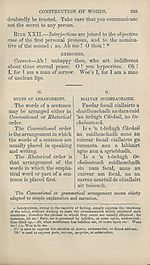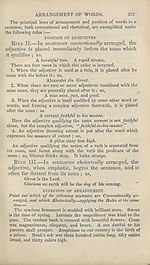Books and other items printed in Gaelic from 1841 to 1870 > Double grammar, of English and Gaelic, in which the principles of both languages are clearly explained
(262) Page 260
Download files
Complete book:
Individual page:
Thumbnail gallery: Grid view | List view

260 ENGLISH SYNTAX.
The Rhetorical or emphatical arrangement is chiefly used in
poetry and pathetic prose."'5
POSITION OF THE ARTICLE.
Rule I.—The article is always placed before the noun
whose signification it limits; as, A pen, an eye, the
Bible.
1. When the noun limited by the article is qualified by an ad¬
jective, the article is placed before the adjective; as, A cold day,
an amiable woman, tlie holy Bible.
2. A is placed between the noun and the adjectives many and
such, and also between the noun and all adjectives preceded by
as, so, too, and how; as,
Many a flower is born to blush unseen.
Such a system is sure to work well.
As fine a lady as one can see.
No fair a maid was never seen.
3. The is placed between the noun and the word all; as, All
the judges assembled.
4. The is placed before the comparative degree of adverbs; as,
the older he grows the wiser he gets; the sooner the better.
A nice distinction is sometimes made by the use or omission of
the indefinite article. Thus, if I say, the farmer showed me a
little kindness, I commend him; but if I say, he showed me little
kindness, I commend him not.
ARRANGEMENT OF WORDS.
EXERCISES.
Place the article right in the following sentences—
Lofty a tree is more exposed to the violence of high the winds
than low a one.
A many poor creature suffers under screwing poverty, while
others abound in wealth to a such high degree as excludes every
thought of want.
A so able and pious man we seldom meet. The all men that
wear a fair outside are not sound within.
A so bold breach of order called for little severity in punishing
the offender. He has been much censured for paying a little at¬
tention to his business.
• The Rhetorical seems to be the more natural of the two kinds of arrangement
described above, as it is more calculated to operate on the mind of the speaker
and tix the attention of the hearer, and also more lively and attractive in ani¬
mated speech. It is the same in all languages, whereas the conventional mode
of arrangement is different in different languages.
The Rhetorical or emphatical arrangement is chiefly used in
poetry and pathetic prose."'5
POSITION OF THE ARTICLE.
Rule I.—The article is always placed before the noun
whose signification it limits; as, A pen, an eye, the
Bible.
1. When the noun limited by the article is qualified by an ad¬
jective, the article is placed before the adjective; as, A cold day,
an amiable woman, tlie holy Bible.
2. A is placed between the noun and the adjectives many and
such, and also between the noun and all adjectives preceded by
as, so, too, and how; as,
Many a flower is born to blush unseen.
Such a system is sure to work well.
As fine a lady as one can see.
No fair a maid was never seen.
3. The is placed between the noun and the word all; as, All
the judges assembled.
4. The is placed before the comparative degree of adverbs; as,
the older he grows the wiser he gets; the sooner the better.
A nice distinction is sometimes made by the use or omission of
the indefinite article. Thus, if I say, the farmer showed me a
little kindness, I commend him; but if I say, he showed me little
kindness, I commend him not.
ARRANGEMENT OF WORDS.
EXERCISES.
Place the article right in the following sentences—
Lofty a tree is more exposed to the violence of high the winds
than low a one.
A many poor creature suffers under screwing poverty, while
others abound in wealth to a such high degree as excludes every
thought of want.
A so able and pious man we seldom meet. The all men that
wear a fair outside are not sound within.
A so bold breach of order called for little severity in punishing
the offender. He has been much censured for paying a little at¬
tention to his business.
• The Rhetorical seems to be the more natural of the two kinds of arrangement
described above, as it is more calculated to operate on the mind of the speaker
and tix the attention of the hearer, and also more lively and attractive in ani¬
mated speech. It is the same in all languages, whereas the conventional mode
of arrangement is different in different languages.
Set display mode to:
![]() Universal Viewer |
Universal Viewer | ![]() Mirador |
Large image | Transcription
Mirador |
Large image | Transcription
Images and transcriptions on this page, including medium image downloads, may be used under the Creative Commons Attribution 4.0 International Licence unless otherwise stated. ![]()
| Permanent URL | https://digital.nls.uk/106542909 |
|---|
| Description | Out-of-copyright books printed in Gaelic between 1631 and 1900. Also some pamphlets and chapbooks. Includes poetry and songs, religious books such as catechisms and hymns, and different editions of the Bible and the Psalms. Also includes the second book ever published in Gaelic in 1631. |
|---|

